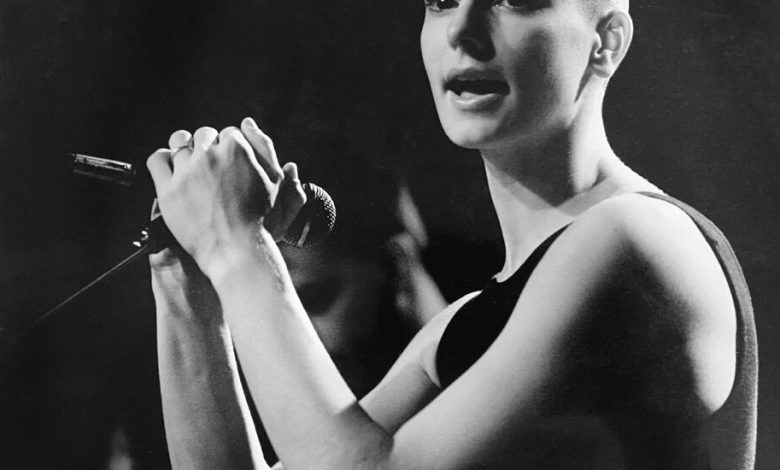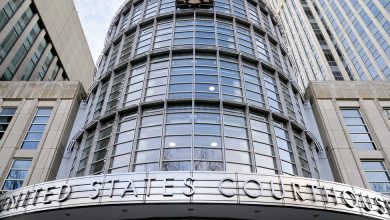Sinead O’Connor Condemned Church Abuse Early. America Didn’t Listen.

Americans began to grapple with a nationwide epidemic of child abuse in Catholic parishes and other religious organizations in 2002, after a landmark Boston Globe investigation revealed a pattern of misdeeds and cover-ups in Boston that went back decades.
Ten years earlier, Sinead O’Connor became a pop culture pariah in the United States for an on-air protest intended to raise awareness of the same problem.
The backlash to her actions — tearing up a picture of Pope John Paul II on “Saturday Night Live” and then shouting “Fight the real enemy!” — was swift.
Prominent Americans, including celebrities like Madonna and Joe Pesci, denounced her. Protesters brought a 30-ton steamroller to crush her cassettes in Rockefeller Center. Catholic leaders were outraged, including some who were forced to resign years later for their roles in covering up abuse.
Many people in America derided her as “somebody looking for attention,” said Cahir O’Doherty, the arts editor of The Irish Voice, an Irish diaspora newspaper in New York City. “It never occurred to anyone that maybe she had a point,” he added.
But back in Ms. O’Connor’s native Ireland, a reckoning over abuse in the church was already beginning.
“In America, she was very, very ahead of her time for doing that,” said Mr. O’Doherty. “She said ‘enough’ and the culture caught up with her.”
The death of Ms. O’Connor at 56, which was announced on Wednesday, was met with an outpouring of remembrances from around the world. But in Ireland and its diaspora communities, there was a more pointed grief at the loss of an artist many saw as both a symbol of and catalyst for a long-needed reckoning over abuse within the church.
Cardinal Bernard Law of Boston, who resigned in 2002, said at the time that her actions were “a gesture of hate.” A spokesman for Cardinal Roger M. Mahony of Los Angeles, who was removed from public duties in 2013, called her actions “just another example of anti-Catholicism.”
On Wednesday, Catholics for Choice, an American group, called Ms. O’Connor a prophetic heroine “unafraid to demand justice for victims of clerical sexual abuse, challenge patriarchy, and speak truth to power — even when her voice was a lonely one and it cost her dearly to do so.”
In the Ireland of Ms. O’Connor’s youth, politics were dominated by the Catholic Church. For decades, priests at the parish level saw part of their role as protecting the community from sexual promiscuity, homosexuality and unwed mothers and their children.
To do so, they used an unwritten, extralegal power to send women accused of such sins to reform schools, workhouses and other facilities run by Catholic orders.
It was a world with which Ms. O’Connor was intimately familiar, and her experiences in one such facility as a teenager, after enduring years of abuse from her mother, set the stage for the moment on “Saturday Night Live.”
“She had already seen what happened to spirited girls and gay kids in Ireland, and to her it wasn’t an abstraction, it was her biography,” said Mr. O’Doherty, who grew up gay in rural Ireland and moved to the United States in 1996. “She came out of an era of silence that swallowed spirited girls and gay boys, that consumed Irish life, and that you could vanish into. And she nearly did.”
In interviews later in life, and in her 2021 memoir, Ms. O’Connor described her mother pinning her to the floor and pummeling her, while forcing her to say over and over again, “I am nothing.”
She grew into a rebellious teenager, skipping school and stealing. After she was caught shoplifting a pair of gold shoes to wear to a rock concert, a social worker suggested that a “rehabilitation center” might set her straight.
That is how, at the age of 14, Sinead O’Connor was sent to live at An Grianán Training Centre in Dublin, which was run by the Order of Our Lady of Charity. It had formerly been a Magdalene Laundry, a facility where a “fallen woman” might spend her entire life washing the dirty laundry of the surrounding community.
The facilities formed a nucleus of physical and sexual abuse in Ireland. A government report in 2009 said tens of thousands of children were abused in industrial schools alone, a staggering figure in a country with barely more than five million people. At one, the Bon Secours Mother and Baby Home in Tuam, the remains of hundreds of babies and fetuses were found in a septic tank in 2017.
An Grianán also housed older women who had been sent there in their youths. In interviews in later years, Ms. O’Connor, who lived there for two years, spoke of interacting with women who were there because they “had their babies taken off them, or because they were sexually abused and complained and nobody believed them.”
Ms. O’Connor said the younger women were kept separated from the older women, but sometimes as punishment the younger girls were sent to sleep in an infirmary wing. She called it “a secret hospice” where older women were sent before they died.
“There was no staff,” she recalled in a 2021 interview. “These ladies were calling out all night, ‘Nurse! Nurse!,’ and there was nobody to come.”
Ms. O’Connor described nights there as horrifying and panic-inducing, but also said she had come to feel “terribly, terribly lucky that god put me” in An Grianán “because otherwise those women, we would never have heard of them.”
The system of abuse had been normalized, spoken of only in hushed tones, in Ireland for decades, Ms. O’Connor said. “But I met them at their dying moment and saw them every day, the way they were treated.”
It was also at An Grianán, she said, that a nun gave her a guitar for the very first time.
By the time Ms. O’Connor became famous in the United States for her first album in 1987 — at the age of 21, just a few years out of An Grianán — the first rumbles of church accountability in her home country had begun. They would grow louder thanks in part to her willingness to describe her own life experiences.
She was a frequent presence at street protests and charity events for a range of social causes, including abortion rights, a procedure she publicly said she had undergone, and equal rights for people of color, migrants and L.G.B.T.Q. people. (Ms. O’Connor described herself as a lesbian in 2000 and as bisexual in 2005, but did not discuss the topic in later years.)
But she became most associated with efforts to combat abuse within the Catholic Church, decades before the scale of the problem within American religious organizations — from the Catholic Church to the Southern Baptist Convention to the Hasidic dynasties of New York — became common knowledge.
One the church’s most high-profile and influential priests in the United States, Theodore E. McCarrick, was expelled from the church in 2019 and is facing sexual assault charges in two states, the first and only American cardinal to be criminally charged in connection with sex abuse.
But in 1992, it was a problem that few people in the United States had thought very much about.
In her memoir, Ms. O’Connor wrote that the picture she tore in half on TV was not just any picture of the pope. It was a picture of the pope’s Mass in the Irish city of Drogheda in 1979, which he dedicated to “the young people of Ireland” and which had drawn 300,000 worshipers.
That same photograph had been the only decoration on her mother’s wall, she wrote, and had looked down on them both as her mother pinned her to the floor and beat her.
After her mother died in a car accident in 1985, she took the picture, determined to someday destroy it. To her it was an object that “represented lies and liars and abuse,” she wrote.
“The type of people who kept these things were devils like my mother,” she wrote. “I never knew when or where or how I would destroy it, but destroy it I would when the right moment came.”
When she took the stage on Saturday Night Live to perform Bob Marley’s “War,” she meant to start a broader conversation, she later said. She even changed the lyrics to make it about the abuse of children. And she had her mother’s picture with her.
As she began to sing, she knew the moment had come.




